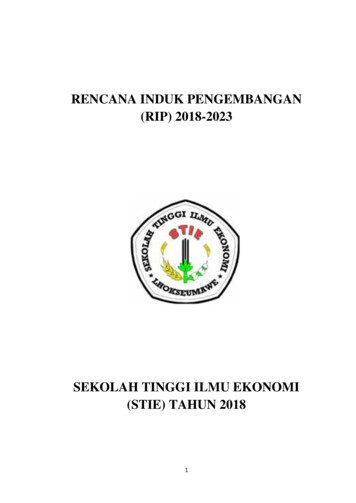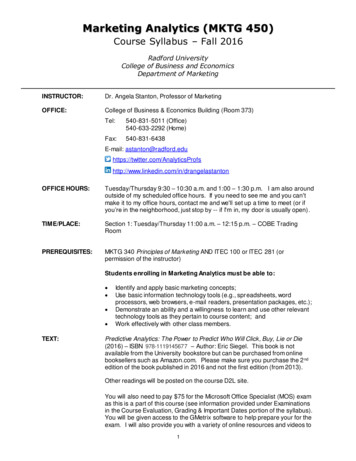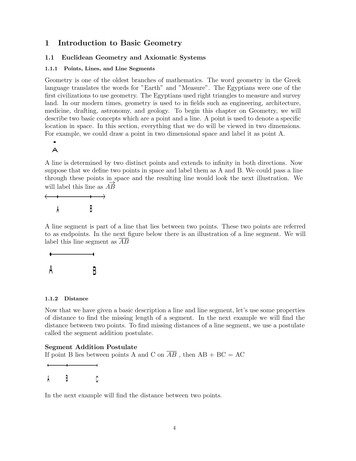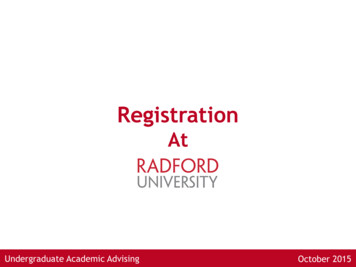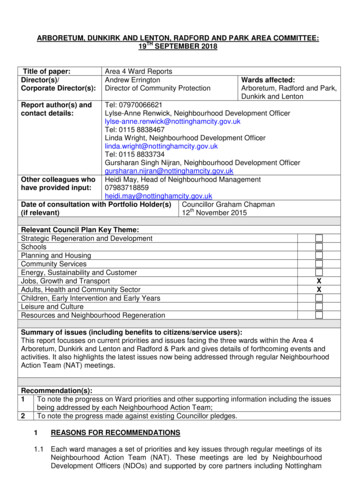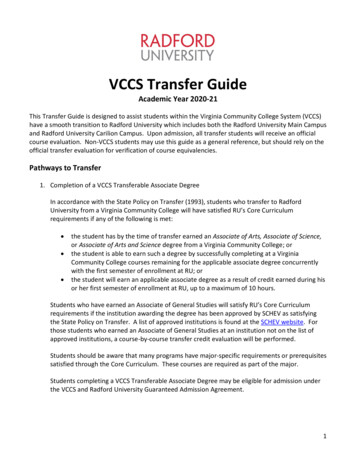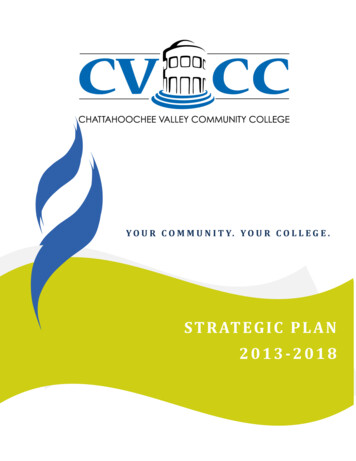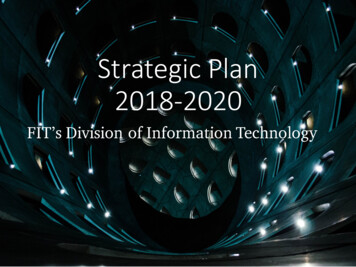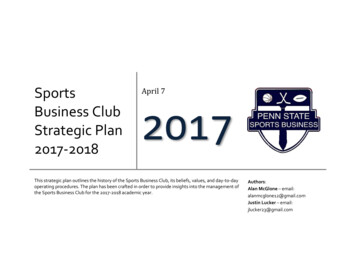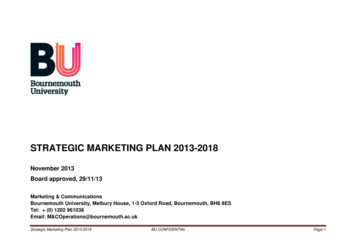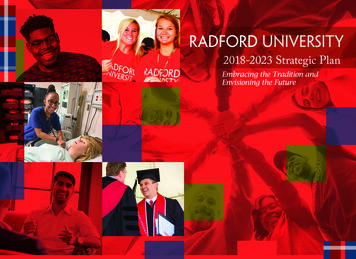
Transcription
2018-2023 Strategic PlanEmbracing the Tradition andEnvisioning the Future
iContentsLetter from the President.iiiForeword from the Task Force Co-Chairs. ivThe History of Radford University . 2The Methodology for Strategic Planning.6Challenges and Opportunities.9Vision, Mission and Core Values. 14Of Interest to the Community . 16Goals and Strategies.17Academic Excellence and Research. 18Brand Identity. 22Economic Development and Community Partnerships. 24Philanthropic Giving and Alumni Engagement. 26Strategic Enrollment Growth. 28Student Success. 32Key Performance Indicators. 35Academic Excellence and Research. 36Brand Identity.40Economic Development and Community Partnerships. 42Philanthropic Giving and Alumni Engagement.44Strategic Enrollment Growth.48Student Success.50Budget.54Acknowledgments. 562018-2023 Strategic Plan
ii
LETTER FROM THE PRESIDENTiiiOn behalf of the Radford family, I am pleased to present RadfordUniversity’s 2018-2023 Strategic Plan: Embracing the Tradition andEnvisioning the Future. The goals identified within this five-year plan reflectthe hopes and dreams of Radford University and those it proudly serves,including our students, faculty, staff, alumni, community and friends. Theplan will drive each of us in our daily interactions and collaborative effortsto selflessly serve current and future generations of Highlanders.Dedicated individuals from the campus community and beyond identifiedthe focal areas within the plan as they worked diligently for more than ayear to reflect on the past and prepare for the future. When this importantwork began, I asked individuals to be creative, innovative and responsiveto future learners and societal needs. I charged them with engaging in theprocess, participating in robust discussions, stepping out of their comfortzones and thinking outside the box. I can proudly say that, throughthe work of a university-wide Task Force and various subgroups, theseindividuals embraced the tradition and, at the same time, envisionedour future.Due to the work of so many, Radford University is poised for limitlessopportunity and future success — success that is only possible due tothe dedication and passion of individuals who devote themselves to theideals and mission of our beloved university. Without question, RadfordUniversity has a storied history built upon strong tradition. With theimplementation of Embracing the Tradition and Envisioning the Future,there is no limit to what the future holds and what we can achievetogether as one Radford family.With Highlander Pride,We must engage the Radford family inits totality in planning and executinga bold and innovative agenda thatpositions us for the future.— President Brian O. Hemphill, Ph.D.Investiture Ceremony, Inaugural Address, October 13, 2016Brian O. Hemphill, Ph.D.President2018-2023 Strategic Plan
ivFOREWORD FROMTHE TASK FORCE CO-CHAIRSAs Co-Chairs of the Radford University Strategic Planning Task Force,we express our sincere appreciation and lasting gratitude to those whocontributed to the in-depth and insightful research, the thoughtful andreflective analysis and the detailed and technical writing of the university’sfive-year strategic plan. Through the work of the Task Force and varioussubgroups, Embracing the Tradition and Envisioning the Future wasdeveloped by a broad-based group of on- and off-campus constituents andsubsequently approved by the Radford University Board of Visitors.During this comprehensive effort and inclusive process, we witnessedfirsthand the direct involvement and dynamic interaction of Task Force andsubgroup members, the active engagement of the campus community, theopen sharing of ideas through forums and surveys and the honest feedbackfrom individuals who have fully invested themselves in our campus and thecommunity. We were truly honored and humbled to be asked to lead thisvital effort by Radford University’s seventh president, Brian O. Hemphill,Ph.D., a visionary leader who created the necessary framework and guidingprinciples for this important process and related work to occur in asupportive community and accepting environment.On behalf of the Task Force, we thank you for serving as dynamic partners inthe development of Radford University’s 2018-2023 strategic plan. It is withmuch excitement and optimism that we look forward to working with each ofyou over the five-year planning cycle to make this plan a reality.Sincerely,Jack E. Call, J.D., Ph.D.Professor of Criminal Justice and Criminal Justice Internship CoordinatorKenna M. Colley, Ed.D.Interim Provost and Vice President for Academic Affairsand former Dean of the College of Education and Human DevelopmentDr. Call, who has devoted his teaching career and scholarly researchto constitutional rights, joined the Radford University faculty in 1985and served as the first Chair of the Department of Criminal Justice.Dr. Colley, who has devoted her career to the teaching professionand the promotion of public education in Southwest Virginia,joined the Radford University College of Education and HumanDevelopment in 1996 and became the Dean in 2015. She was namedInterim Provost and Vice President for Academic Affairs in fall 2017.
2018-2023 Strategic Plan
21913 A Tradition of ChangeThe first studentsenter the StateNormal andIndustrial Schoolfor Women atRadford and enrollin a two-yeardegree program.1921The first bachelor’sdegrees are awarded.THE HISTORY OFRADFORD UNIVERSITYThe institution that became Radford Universityhas leaned toward a future based on innovation,excellence and response to student and publicneeds since its charter in 1910. Founding presidentJohn Preston McConnell’s advocacy for women’seducation set him apart from his scholarly peers.He dedicated more than two decades to buildingand growing a school charged initially withpreparing women to teach in Virginia’s emergingpublic school system.In 1913, the first students who entered the StateNormal and Industrial School for Women atRadford enrolled in a two-year degree program.At a time when teacher certification required onlysix weeks of study and passing a state exam, theRadford school established the highest qualificationfor a Virginia teacher. One of McConnell’s firstinnovations was a partnership with Radford Cityallowing students to practice-teach in the schools,a way of lifting them even higher.Within five years of opening, Radford beganoffering four-year programs. In 1921, the firstbachelor’s degrees were awarded. The normalschool became Radford State Teacher’s College in1924. This status paved the way to offer four-yearprograms in any field.At Radford, students were involved in debate,athletics, journalism, music and drama. The campuscommunity worked to improve and preserve thegrounds. Students grew hollyhocks and irises andplanted trees to commemorate special occasions.McConnell, his staff and students experienced thelean times of World War I and the high-spiritedRoaring Twenties, when women gained the rightto vote and sought new independence. They alsoexperienced the Great Depression of the 1930s.Even in difficult times, enrollment, programsand facilities grew. The John Preston McConnellLibrary opened in 1932, in the midst of theDepression. Students carried books from the oldlibrary in the Administration Building to the new,200,000-volume-capacity facility.McConnell took personal interest in each student’ssuccess. When a student could not afford to payfor college, he worked with community membersand businesses to help. This legacy was repeated1932The John PrestonMcConnell Library opens.
19641972Radford College separatesfrom Virginia Tech.3The college doubles itsrecruitment pool by admittingmale undergraduates.by his successor, David Wilbur Peters, and Peters’successor, Charles Knox Martin Jr.Peters, Radford’s president from 1938 until his deathin 1951, guided the college through World War IIair-raid drills, bandage preparation, rationing offood and shoes and writing letters to troops. Theseactivities were a vital part of everyday life.In 1944, in an efficiency move for the war, RadfordCollege consolidated with Virginia Tech and becameknown as Radford College, the Women’s Division ofVPI. Both institutions maintained their own identitiesand governance, but the merger helped Petersobtain funds for a 3 million long-range expansionplan, including a new administration building, gymand residence halls. Construction moved outwardfrom the original campus, where the central greenspace has been protected for more than 100 years.The merger lasted until 1964, when, under the tenureof Charles Martin, the two schools quietly separated.Martin presided over a time of unprecedentedgrowth, between 1952 and 1972, when enrollmentgrew from 800 to 4,000. During the same time, 19new buildings went up, and faculty multiplied by afactor of five. Radford became the largest women’sschool on the east coast. Admission standardswere raised, and Martin lifted faculty credentialsby encouraging his teachers to pursue doctoraldegrees and granting them leave to do so.By the end of Martin’s presidency, however,enrollment was declining. Those two decadeswitnessed national social upheaval that was echoedon campus. In loco parentis, a concept still cherishedby administrators, lost ground with students duringthe 1960s. Although Radford’s protests of campusrules and the Vietnam War were tame comparedto those of some schools, students were ready forchange. President Donald Dedmon arrived in 1972ready to embrace it.In the fall of that year, the college instantlydoubled its recruitment pool by admitting maleundergraduates. Dedmon instituted a groundbreakinguniversity governance system that included studentrepresentation. The Foundation was established tosteward funds raised for student scholarships andinstitutional initiatives. Over the next two decades,enrollment went from 3,600 to 9,500, and facultydoubled to 500.Community members, students, faculty and staffsupported the new intercollegiate athletics programestablished in 1974. The first athletic directorrecruited men’s basketball players out of courseregistration lines, but within 10 years, Radford was anNCAA Division I school and a charter member of theBig South Conference in men’s and women’svarsity sports.New construction flourished. Perhaps the mostsignificant project was the Donald N. DedmonCenter, a recreational, intramural and athleticsconvocation center with a distinctive designfeaturing an air-supported roof. Dedmon convincedNorfolk and Western Railway to donate the 62-acresite beside the New River and persuaded the state toconstruct a bridge over the train tracks for access.In 1979, Radford College became RadfordUniversity, an achievement celebrated by all2018-2023 Strategic Plan
419792008of 71 million raised in just 10 years. In 1993, theRadford University Foundation had been capable ofsupporting 123 scholarships; by 2004, the numberwas 600.initiative provided mentors for high school studentsidentified by their teachers as college able but notnecessarily college bound. Selu Conservancy, withits retreat center, observatory, 1930s farmhousereplica and conference and event center, became aresource for the campus andthe community, which has evolved into a center forresearch, teaching and scholarship providing uniqueopportunities for students and faculty.Radford College becomesRadford University.Radford Universityoffers its first doctoralprogram, the Doctorof Psychology.constituencies. This status marked a new chapter inRadford’s history — one that was marked by manyachievements from across the campus andthe community.Radford’s faculty-led Writing Across the Curriculumprogram became a national model. The programencouraged a culture of cross-disciplinarycollaboration and a tradition of peer-to-peerfaculty development. A new Distinguished VisitingProfessor program and Scholarly Lecture Seriesbrought former Egyptian First Lady Jehan Sadat,legendary poet Maya Angelou, Supreme CourtJustice Arthur Goldberg and other prestigiousvisitors to the campus and classrooms.Radford claimed a leading edge in technology, fromits music technology program to its website, amongthe state’s first. In response to an increasinglyinterconnected world, the university developed newinternational education opportunities. Curricularofferings expanded in response to students’interests, public need and the changing world.Before Dedmon stepped down in 1994, degreeprograms had increased from 83 to more than 100.Douglas Covington became the fifth presidentand first African-American leader of the institutionin 1995. Students, faculty and staff soon becamefamiliar with Covington’s soft-spoken manner as hegreeted — and listened to — all he met.Early in Covington’s presidency, the universityundertook its first capital campaign, a three-yeareffort that exceeded its goal. It was followed by asecond successful campaign, with a combined resultThe institution continued the tradition of innovativepartnerships and outreach. The Regional ClinicalSimulation Center’s electromechanical patientsimulators began providing safe hands-onexperience to students from Radford, JeffersonCollege of Health Sciences and community collegepartners. The Appalachian Studies Program’sAppalachian Arts and Studies in the SchoolsStudents and faculty collaborated on research inthe laboratory, in the community and in far-flungsites, including the North Pole. A new College
2010The Doctor of NursingPractice program opens.201630 percent of full-time freshmenwho enrolled in fall 2016 identify aspart of an ethnic minority group.of Information Science and Technology opened.Construction included Cook Hall, the WaldronCollege of Health and Human Services and theBonnie Hurlburt Student Center, and plans were laidfor what would be one of the most technologicallyadvanced arts venues in the southeast.Ground was broken for the Douglas and BeatriceCovington Center for Visual and Performing Artssoon after the 2005 arrival of Penelope W. Kyle,Radford University’s first female president. TheCovington Center was the first in an extensivelist of new construction and renovation projectscompleted during her 11-year presidency. KyleHall, a 116,000-square-foot home for the Collegeof Business and Economics, incorporates neweducational technology, including a signaturetrading room; the 114,000-square-foot Centerfor the Sciences houses the Artis College ofScience and Technology’s Planetarium, Museumof Earth Sciences and Forensic Science Institute;a 110,000-square-foot Student Recreation andWellness Center features an indoor graded track,multi-use court, racquetball courts and classrooms;and a 144,000-square-foot new home for theCollege of Humanities and Behavioral Sciencesincludes a courtroom for mock trials and atelevision studio.The Gold and Silver LEED status for variousrenovated and new structures reflects theinstitution’s strides in environmental sustainability.In 2009, Kyle signed the American College andUniversity Presidents’ Climate Commitment.Through a network of initiatives, Radford isbecoming a model of sustainability practices andpolicies and has been included among PrincetonReview’s “Top Green Colleges in the Nation”since 2010.The institution’s academic status rose with theintroduction of its first doctoral offering, the Doctorof Psychology program, which enrolled studentsin 2008. The Doctor of Nursing Practice programopened in 2010, and the next year students enteredthe new Doctor of Physical Therapy program.A remarkable change in student diversity occurredduring this period. Approximately 30 percent of20185The Radford familyimplements a boldvision for the futurewith the adoption andimplementation of anew strategic plan.full-time freshmen who enrolled in fall 2016 and fall2017 identify as part of an ethnic minority group —a leap from the 12 percent who did so in fall 2005.The fastest-growing populations are Black/AfricanAmerican and Hispanic.Radford University’s seventh president, Brian O.Hemphill, began his tenure in 2016 by invitingstudent, faculty, staff, alumni and communityreflection on how to embrace the best of Radford’spast, while contemplating the future of a greatinstitution that has never stopped changing. This iswhere the new story of Radford University begins.2018-2023 Strategic Plan
6THE METHODOLOGY FORSTRATEGIC PLANNINGTHE CONTEXTHigher education, particularly public highereducation, faces opportunities and challengesunlike any other industry. In light of these realities,the Radford University Strategic Planning TaskForce and working subgroups considered severalsignificant points regarding the context ofcontemporary American higher education. First,students today are not the same as studentsduring previous generations, so we must adaptto these new learners. The demographics of ourstudent population are more diverse and representa broader variety of backgrounds. Students learnusing different techniques and personal preferences,especially via technology. Second, in light of therapid changes in all aspects of our culture, we mu
University’s 2018-2023 Strategic Plan: Embracing the Tradition and Envisioning the Future. The goals identified within this five-year plan reflect the hopes and dreams of Radford University and those it proudly serves, including our stu

